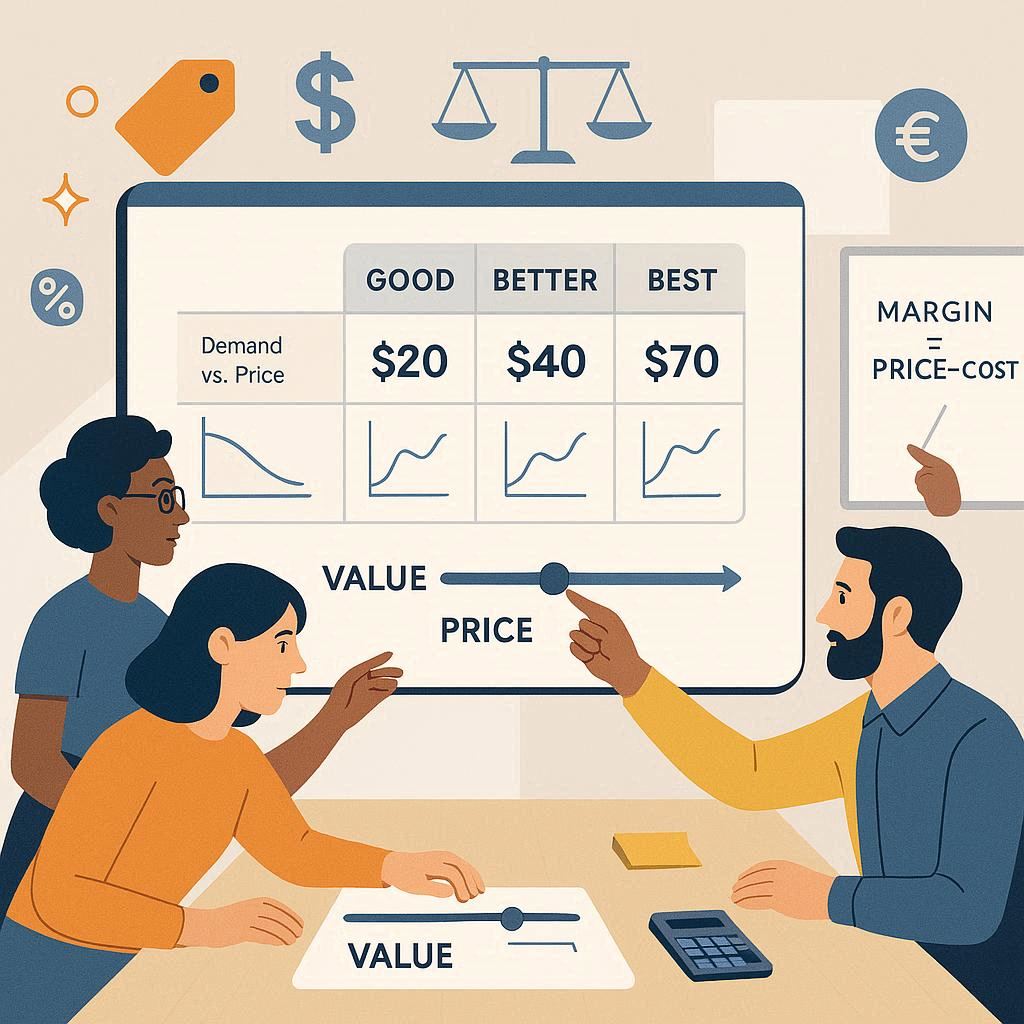Pricing is one of those decisions that looks simple from the outside—stick a number on it and go. In reality, it’s a balancing act between value, costs, market dynamics, and psychology. Price too low and you erode margins or signal “cheap.” Price too high and you create friction or stall growth. The goal isn’t to pick the “right” number once—it’s to create a pricing system you can test, learn from, and refine.
Below is a straightforward framework to help you do exactly that.
1) Start with value, not cost
Costs matter (we’ll get there), but value should lead. Ask: what outcome does your product create, and how much is that worth to your customer? If your offer saves a business ten hours a week or helps a runner avoid injury, that perceived value sets an upper bound. A simple exercise: list your top three customer outcomes, then estimate the monetary or emotional value of each. That anchors you above “commodity” pricing and points you toward a compelling story to match the number.
2) Know your floor: fully loaded costs
Your price must clear your break-even threshold. Include variable costs (COGS, shipping, transaction fees) and a fair share of fixed costs (software, salaries, rent) plus your target margin. A quick formula:
Price ≥ (COGS + variable fees) / (1 – target margin)
Adjust for fixed-cost recovery as volume grows.
3) Map the competitive landscape
Customers don’t evaluate you in a vacuum. Scan competitor price ranges, packages, and what’s included. If you’re premium, make the “why” obvious (quality, speed, support, brand, outcomes). If you’re budget, make trade-offs clear without undermining trust. Avoid the mushy middle where your price is similar but your differentiation is vague.
4) Use simple packaging to widen your market
Tiered pricing (Good/Better/Best) lets different segments self-select. Keep tiers clean: one promise per tier, with meaningful jumps in value. Add-ons can work, but don’t turn pricing into a maze. When in doubt, reduce choices; clarity converts.
5) Apply practical psychology (ethically)
- Charm pricing ($29 vs. $30) can slightly boost conversion.
- Anchoring works: show a higher reference plan to make the middle tier feel reasonable.
- Price endings: round numbers feel premium; .99 feels value-oriented.
- Framing: “$1.30/day” can feel more approachable than “$39/month.”
Use these to communicate value—not to trick people.
6) Run experiments, not thought experiments
You’ll learn more from two weeks of A/B testing than months of debate. Test:
- Small price lifts (5–10%) to gauge elasticity
- Plan structures (monthly vs. annual, bundles vs. à la carte)
- Guarantees (30-day no-questions-asked) to reduce perceived risk
Watch both conversion and downstream metrics like churn, repeat purchase, and support burden.
7) Align price with positioning and promise
If your brand signals craftsmanship, reliability, or concierge care, your price should reinforce that. Conversely, if you emphasize speed and affordability, own that positioning proudly. Mismatched pricing and messaging create cognitive dissonance that kills trust.
8) Revisit pricing with milestones, not moods
Set triggers for review—new feature releases, major cost shifts, seasonality, or hitting a new scale of demand. Communicate increases transparently and offer existing customers a grace period or “grandfathered” rate. Predictability builds loyalty.
9) Don’t forget the math after the launch
Track unit economics by cohort. Your pricing is working when:
- Contribution margin is healthy at realistic volume
- Paid acquisition payback windows are acceptable
- LTV/CAC stays strong after discounts and promotions
If your margins are thin, improve packaging, reduce discounting, or introduce a higher-value tier.
A helpful deep dive
If you want a structured walkthrough with examples and tactics you can apply today, this guide on how to price a product offers a clear, step-by-step approach.
Quick checklist
- What outcome do we sell, and what’s it worth?
- Do our tiers map cleanly to segments?
- Are we at least clearing our fully loaded costs with target margin?
- What small, low-risk tests can we run this month?
- Does our price feel like our brand?
Get those right, and pricing shifts from guesswork to growth lever.







